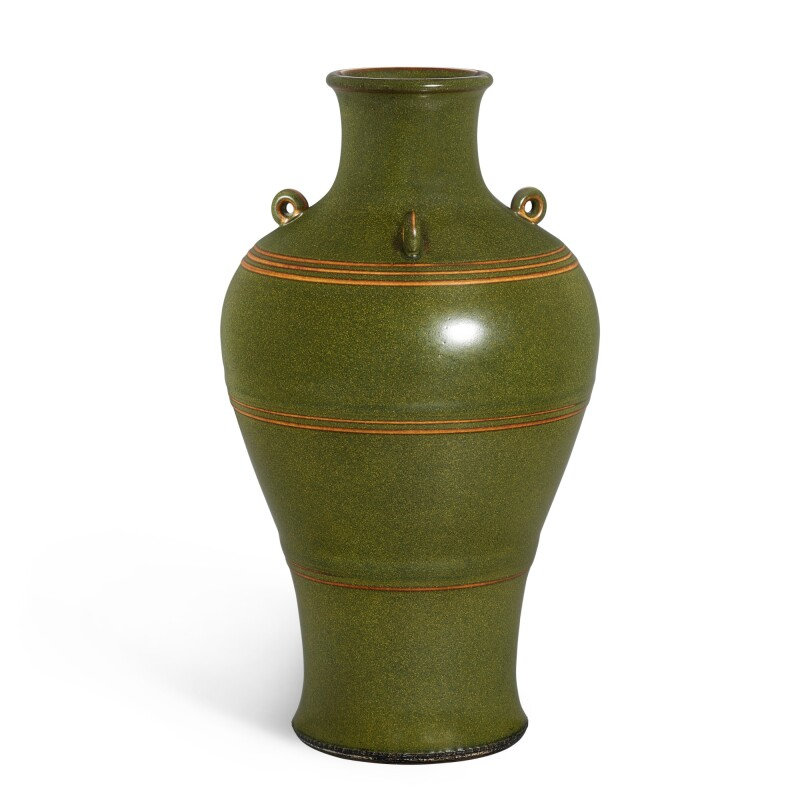An eel-skin-glazed three-handled meiping, Seal mark and period of Yongzheng (1723-1735)
Lot 3614. An eel-skin-glazed three-handled meiping, Seal mark and period of Yongzheng (1723-1735); 28.2 cm. Lot sold 1,260,000 HKD (Estimate : 1,000,000 - 1,500,000 HKD). © Sotheby's 2022
Note: The present vase is particularly notable for its lustrous and deep mottled green glaze, which has been achieved through the precipitation of yellow crystal that stands out against the dark green background. Successfully fired vessels have many stipples that make the glaze appear especially rich, as seen in this vase. The loop handles and the raised ribs, as well as the glaze appearance, recall archaistic bronze vessels, which probably served as inspirations for the artisans.
Under the Yongzheng Emperor, craftsmen were directed to use antiques in the Palace collection as standards for quality, models for archaistic designs and as inspiration for innovation. The simplicity of form and absence of decoration were stylistic trends introduced by Tang Ying (1682-1756), superintendent of the imperial kilns in Jingdezhen.
Vases of this type in teadust or eel-skin glazes are rare. Compare a guan-type glazed version, in the Palace Museum, Beijing, illustrated in Qingdai yuyao ciqi [Qing porcelains from the imperial kilns preserved in the Palace Museum], vol. 1, pt. 2, Beijing, 2005, pl. 154; and a celadon-glazed example sold in these rooms, 8th October 2009, lot 1635.
This form was adopted and adapted slightly by the Qianlong Emperor, who exaggerated the swelling form by decreasing the size of the neck and increasing the fullness of the shoulders. See two Qianlong teadust-glazed examples, one in the Idemitsu Museum of Arts, Tokyo, illustrated in Chinese Ceramics in the Idemitsu Collection, Tokyo, 1987, pl. 963, and the second, in the Hakutsuru Art Museum, Kobe, published in Sekai toji zenshu/Ceramic Art of the World, Tokyo, 1956, vol. 12, pl. 99.
Sotheby's. Important Chinese Art including Jades from the De An Tang Collection and Gardens of Pleasure – Erotic Art from the Bertholet Collection, Hong Kong, 29 April 2022

/https%3A%2F%2Fprofilepics.canalblog.com%2Fprofilepics%2F1%2F0%2F100183.jpg)
/https%3A%2F%2Fstorage.canalblog.com%2F03%2F02%2F119589%2F96711876_o.jpg)
/https%3A%2F%2Fstorage.canalblog.com%2F11%2F31%2F119589%2F94773502_o.jpg)
/https%3A%2F%2Fstorage.canalblog.com%2F20%2F83%2F119589%2F94772815_o.jpg)
/https%3A%2F%2Fstorage.canalblog.com%2F26%2F72%2F119589%2F75604929_o.jpg)
/https%3A%2F%2Fstorage.canalblog.com%2F59%2F60%2F119589%2F26458628_o.jpg)





/http%3A%2F%2Fstorage.canalblog.com%2F19%2F76%2F119589%2F122873625_o.jpg)
/http%3A%2F%2Fstorage.canalblog.com%2F38%2F82%2F119589%2F129424760_o.jpg)
/http%3A%2F%2Fstorage.canalblog.com%2F40%2F22%2F119589%2F129148864_o.jpg)
/http%3A%2F%2Fstorage.canalblog.com%2F51%2F71%2F119589%2F127818288_o.jpg)